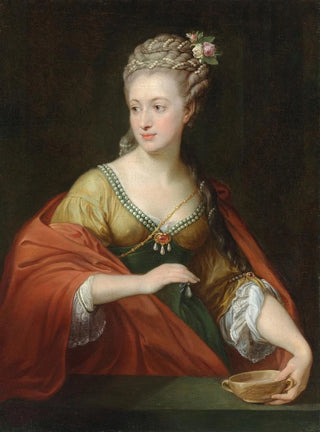Art print | Portrait of a lady traditionally identified as Alexandra Evichovna Demidov in the role of Cleopatra - Pompeo Batoni


View from behind

Frame (optional)
In the vast panorama of art history, certain works stand out for their ability to capture the essence of an era while evoking deep emotions. The art print "Portrait of a lady traditionally identified as Alexandra Evichovna Demidov in the role of Cleopatra" by Pompeo Batoni is one such creation. Through this masterpiece, the artist does not merely depict an iconic historical figure but transcends the limits of traditional portraiture to offer a vibrant and complex vision of his subject. The encounter between the beauty of the woman and the majesty of Cleopatra creates a fascinating atmosphere, where every detail reveals a story that is both personal and universal.
Style and uniqueness of the work
Batoni's style is characterized by refined elegance, mastery of colors, and meticulous attention to detail. In this portrait, light plays a crucial role, illuminating the lady's face with an almost unreal softness, while shadows add depth and volume. The artist manages to infuse a palpable life into his subject, capturing not only her physical appearance but also a part of her soul. The sumptuous drapes of her clothing, inspired by ancient costumes, testify to thorough historical research and a desire to connect the past with the present. This fusion of realism and idealization makes the work a perfect example of rococo style, where beauty is sublimated and each visual element contributes to a rich and evocative narration.
The artist and his influence
Pompeo Batoni, an emblematic figure of the 18th century, established himself as a master of portraiture through his innovative approach and ability to marry tradition and modernity. Trained in Rome, he was influenced by the great masters of the Renaissance while developing a personal style that is uniquely his own. His work is marked by a keen sense of composition and a deep understanding of human emotions. By choosing to depict a woman in the role of Cleopatra, Batoni does not limit himself to a simple stylistic exercise; he engages in a dialogue

Matte finish

View from behind

Frame (optional)
In the vast panorama of art history, certain works stand out for their ability to capture the essence of an era while evoking deep emotions. The art print "Portrait of a lady traditionally identified as Alexandra Evichovna Demidov in the role of Cleopatra" by Pompeo Batoni is one such creation. Through this masterpiece, the artist does not merely depict an iconic historical figure but transcends the limits of traditional portraiture to offer a vibrant and complex vision of his subject. The encounter between the beauty of the woman and the majesty of Cleopatra creates a fascinating atmosphere, where every detail reveals a story that is both personal and universal.
Style and uniqueness of the work
Batoni's style is characterized by refined elegance, mastery of colors, and meticulous attention to detail. In this portrait, light plays a crucial role, illuminating the lady's face with an almost unreal softness, while shadows add depth and volume. The artist manages to infuse a palpable life into his subject, capturing not only her physical appearance but also a part of her soul. The sumptuous drapes of her clothing, inspired by ancient costumes, testify to thorough historical research and a desire to connect the past with the present. This fusion of realism and idealization makes the work a perfect example of rococo style, where beauty is sublimated and each visual element contributes to a rich and evocative narration.
The artist and his influence
Pompeo Batoni, an emblematic figure of the 18th century, established himself as a master of portraiture through his innovative approach and ability to marry tradition and modernity. Trained in Rome, he was influenced by the great masters of the Renaissance while developing a personal style that is uniquely his own. His work is marked by a keen sense of composition and a deep understanding of human emotions. By choosing to depict a woman in the role of Cleopatra, Batoni does not limit himself to a simple stylistic exercise; he engages in a dialogue






